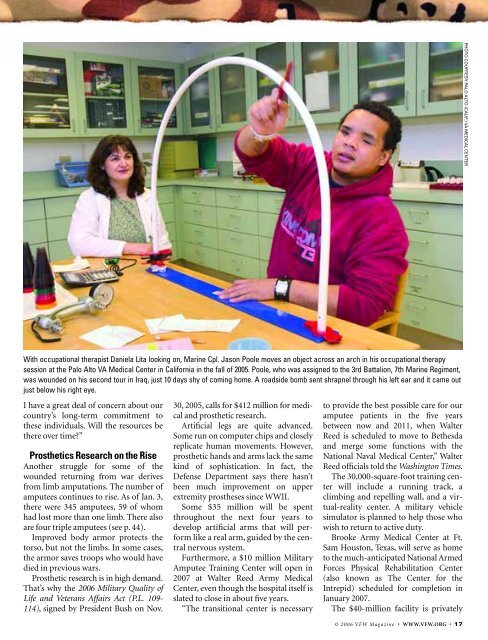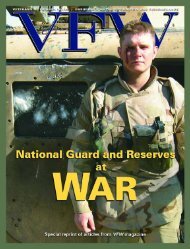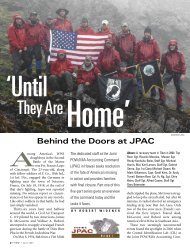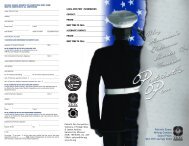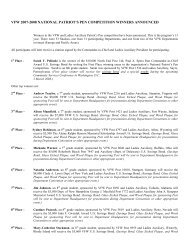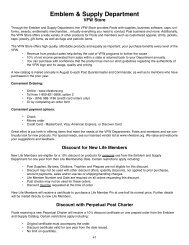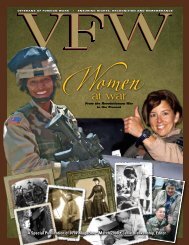2006 VFW Magazine - Veterans of Foreign Wars
2006 VFW Magazine - Veterans of Foreign Wars
2006 VFW Magazine - Veterans of Foreign Wars
You also want an ePaper? Increase the reach of your titles
YUMPU automatically turns print PDFs into web optimized ePapers that Google loves.
PHOTO COURTESY PALO ALTO (CALIF.) VA MEDICAL CENTER<br />
With occupational therapist Daniela Lita looking on, Marine Cpl. Jason Poole moves an object across an arch in his occupational therapy<br />
session at the Palo Alto VA Medical Center in California in the fall <strong>of</strong> 2005. Poole, who was assigned to the 3rd Battalion, 7th Marine Regiment,<br />
was wounded on his second tour in Iraq, just 10 days shy <strong>of</strong> coming home. A roadside bomb sent shrapnel through his left ear and it came out<br />
just below his right eye.<br />
I have a great deal <strong>of</strong> concern about our<br />
country’s long-term commitment to<br />
these individuals. Will the resources be<br />
there over time”<br />
Prosthetics Research on the Rise<br />
Another struggle for some <strong>of</strong> the<br />
wounded returning from war derives<br />
from limb amputations. The number <strong>of</strong><br />
amputees continues to rise. As <strong>of</strong> Jan. 3,<br />
there were 345 amputees, 59 <strong>of</strong> whom<br />
had lost more than one limb. There also<br />
are four triple amputees (see p. 44).<br />
Improved body armor protects the<br />
torso, but not the limbs. In some cases,<br />
the armor saves troops who would have<br />
died in previous wars.<br />
Prosthetic research is in high demand.<br />
That’s why the <strong>2006</strong> Military Quality <strong>of</strong><br />
Life and <strong>Veterans</strong> Affairs Act (P.L. 109-<br />
114), signed by President Bush on Nov.<br />
30, 2005, calls for $412 million for medical<br />
and prosthetic research.<br />
Artificial legs are quite advanced.<br />
Some run on computer chips and closely<br />
replicate human movements. However,<br />
prosthetic hands and arms lack the same<br />
kind <strong>of</strong> sophistication. In fact, the<br />
Defense Department says there hasn’t<br />
been much improvement on upper<br />
extremity prostheses since WWII.<br />
Some $35 million will be spent<br />
throughout the next four years to<br />
develop artificial arms that will perform<br />
like a real arm, guided by the central<br />
nervous system.<br />
Furthermore, a $10 million Military<br />
Amputee Training Center will open in<br />
2007 at Walter Reed Army Medical<br />
Center, even though the hospital itself is<br />
slated to close in about five years.<br />
“The transitional center is necessary<br />
to provide the best possible care for our<br />
amputee patients in the five years<br />
between now and 2011, when Walter<br />
Reed is scheduled to move to Bethesda<br />
and merge some functions with the<br />
National Naval Medical Center,” Walter<br />
Reed <strong>of</strong>ficials told the Washington Times.<br />
The 30,000-square-foot training center<br />
will include a running track, a<br />
climbing and repelling wall, and a virtual-reality<br />
center. A military vehicle<br />
simulator is planned to help those who<br />
wish to return to active duty.<br />
Brooke Army Medical Center at Ft.<br />
Sam Houston, Texas, will serve as home<br />
to the much-anticipated National Armed<br />
Forces Physical Rehabilitation Center<br />
(also known as The Center for the<br />
Intrepid) scheduled for completion in<br />
January 2007.<br />
The $40-million facility is privately<br />
© <strong>2006</strong> <strong>VFW</strong> <strong>Magazine</strong> • WWW.<strong>VFW</strong>.ORG • 17


